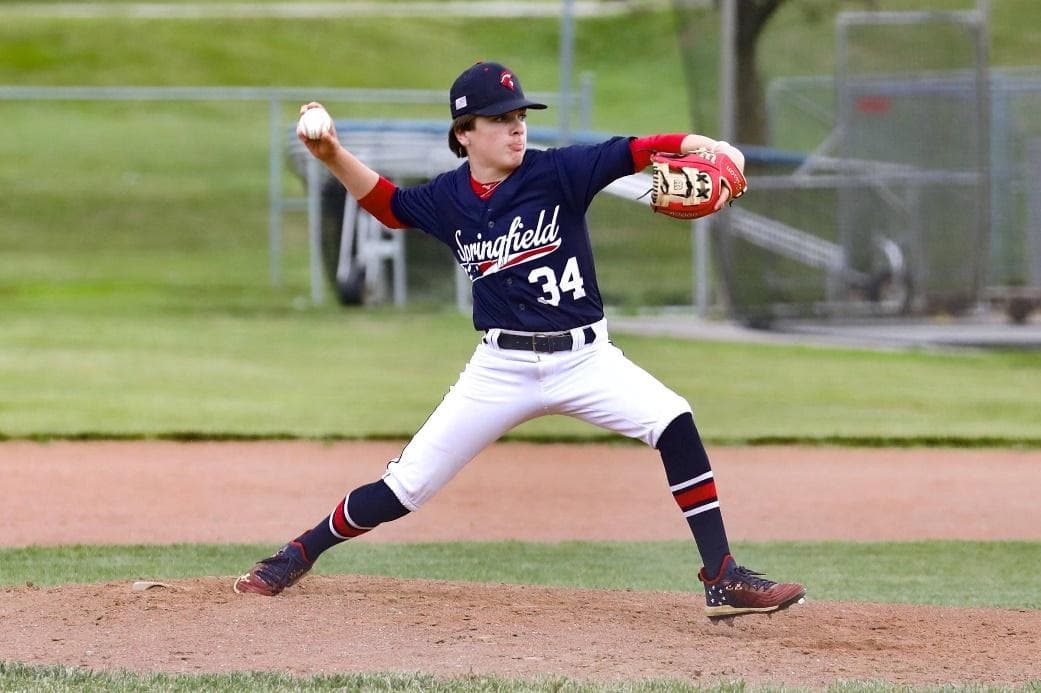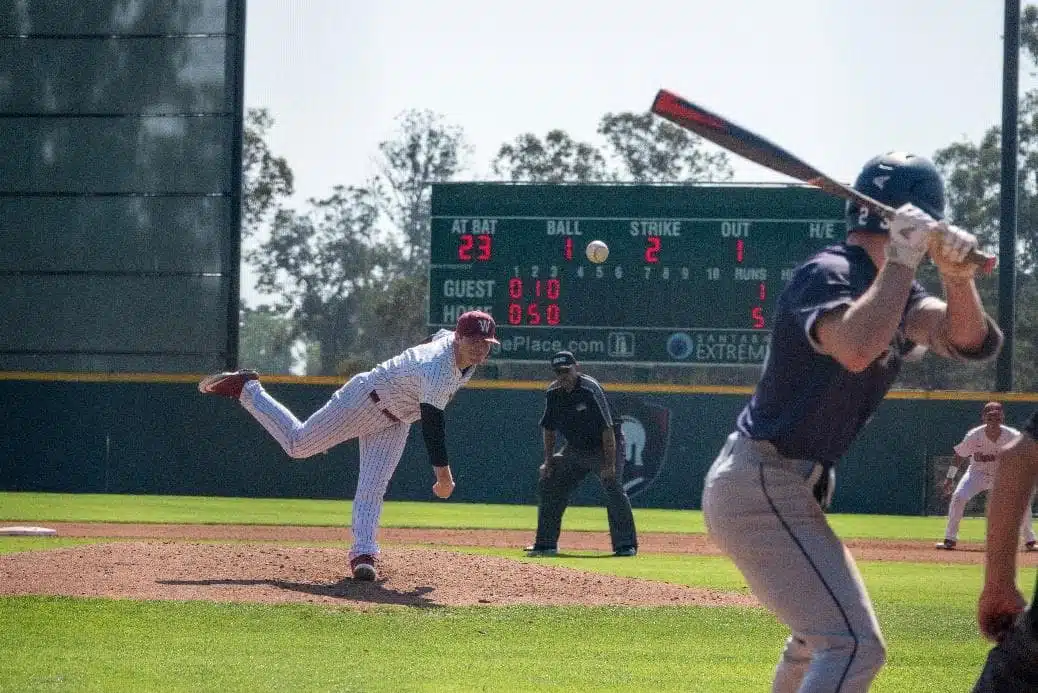4 de December de 2022
Baseball Velocity Training: How to Throw Faster
Specific Training Needs of The Baseball Pitcher to Gain Velocity

Pitching velocity is one of the most highly valued performance metrics in baseball. Since the radar gun was introduced in baseball in the 1960s, pitching velocity has become a major part of evaluating pitching talent (Erickson et al., 2020). That is the reason why many players and coaches are looking for ways to throw faster in baseball to make it as difficult as possible for the batter to hit. Getting that velocity up is not an easy task since pitching is a complex movement that needs the coordination of the whole body while moving as fast as possible (Weber, Kontaxis, O’Brien, & Bedi, 2014).
There are non-modifiable characteristics of the athlete, such as height or bone structure, that directly influence throwing velocity (Sgroi et al., 2015). In contrast, there are other characteristics modifiable with training, such as strength and power, which are important contributors to throwing velocity (Bourdin et al., 2010). High values of strength and stiffness in the lower extremities, and strength and velocity characteristics for the upper extremities, may be associated with athletic performance in throwing (Bourdin et al., 2010).
Biomechanical analysis to understand how to pitch faster in baseball through training
The goal of throwing is to get the ball out of the hand as fast as possible. The energy starts in the legs, and is transferred down the trunk to the shoulder, elbow and hand. The wrist is the last link in the chain that has started in the legs. By evaluating the biomechanics of the pitcher shown in the image below (Weber et al., 2014), we can solve the question at hand in this article: how to pitch faster in baseball.

Throwing in baseball is divided into six phases that we can see in the image above. It is important to dwell on them for a minute because they will serve as a guide to know how to throw faster in baseball. If you are familiar with the sport, you will already know them, but if not, you may have to revisit it several times when you read the sections on baseball specific training. These are the six phases of throwing:
- Wind up (A-B): put the body in the most advantageous position possible to perform the throw.
- Stride (C-D): we start to generate speed by arming the arm and separating the legs. This phase ends when the front leg touches the ground.
- Arm cocking (E-F): we extend the shoulder as far back as possible to have the maximum range of motion in the next phase.
- Arm acceleration (G): the movement of taking advantage of the strength coming from the legs and adding to it the strength of the arm itself
- Arm deceleration (H)
- Follow-through (I)
Training to increase baseball pitcher’s arm velocity

Professional players seeking how to pitch faster in baseball participate in a variety of general and sport-specific training activities, including plyometric and endurance exercises (Ebben, Hintz, & Simenz, 2005). Strength training in all its manifestations (maximal, explosive…) improves throwing velocity in baseball (Lachowetz, Evon, & Pastiglione, 1998) and other sports such as cricket, water polo and handball.
The basis of strength is achieved with basic and general movements such as squats, hip thrust, bench press or military press, among many others. This general preparation is common to all sports, but the important thing to increase the speed of the pitch is that we apply this general strength specifically to baseball. In the following section we will describe the training demands of this sport, as well as some examples of exercises to improve each of them.
Scrolling or Lateral displacement
The velocity of the throw depends on the application of lateral force when moving from wind-up to stride with a lateral stride. We will have to introduce strength exercises with this lateral component to improve in this aspect. Here are three movements, from less explosive to more explosive. This section includes all the exercises that involve a training similar to a leg in a lateral vector. The fourth and last exercise simulates the same gesture of a pitcher, so it is the most interesting if we are looking for how to throw faster in baseball.
Goblet lateral squat https://youtu.be/i0Z5JuNiqUk
Drop in lateral lunge https://youtu.be/-gBrHwG_6pE
Banded skater jumps https://athleteacademy.us/velocity-exercises/
Lateral to forward drop-in lunge https://youtu.be/hDzTdBz_gXw
Unipodal force and power application
The application of force occurs on one leg, which makes unilateral lower body work essential. Here we can train from heavy work on one leg to explosive and plyometric work, also on one leg. Some exercises that serve as examples are the following.
Bulgarian squat https://www.youtube.com/watch?v=jNihW0WDIL4
Split Squat Jumps https://www.youtube.com/watch?v=AmgM_PjBq0I
Core as a connector between legs and throwing arm
The force of the lower body is transmitted through the core muscles to the arm with a rotational movement. In addition, the rotation of the trunk not only connects the lower and upper body, but is also used to give even more speed to the movement. There are an infinite number of core rotation exercises, some of which are described below.
Hip rotation with cable https://www.youtube.com/watch?v=ufTLers22Hc
Landmine twist https://www.youtube.com/watch?v=oiZFDIWsqMk
Rotational med ball throw https://www.youtube.com/watch?v=SgcyVVYytwY
Step-Behind Rotational Med Ball Scoop Tosshttps://www.youtube.com/watch?v=5Ac54pRhQ-U
Rotator cuff strengthening (90/90)
One of the last movements of the arm before reaching the wrist and releasing the ball is the internal rotation of the shoulder. All the speed that we have been developing since the first movement of preparation for the throw will be determined by this internal rotation of the rotator cuff. There are several exercises to improve this part of the throw, which should always be performed in a 90/90 position, that is, with the elbow at 90 degrees. and shoulder at 90 degrees.
Half-kneeling 90/90 ER/IR Holds https://www.youtube.com/watch?v=OioSZHge7F4
90/90 Shoulder Internal Rotation https://www.youtube.com/watch?v=gfm2CV2GJ8k
Heavier and lighter balls
A standard regulation baseball weighs five ounces, about 140 grams. Many programs looking at how to throw faster in baseball use heavier baseballs up to 32 ounces, about 900 grams (Caldwell, Alexander, & Ahmad, 2019; Reinold, Macrina, Fleisig, Aune, & Andrews, 2018). Throwing with heavier baseballs can improve throwing mechanics, as well as the arm strength and velocity, leading to a higher throwing velocity. The drawback is that load and fatigue must be controlled because this strategy can significantly increase the risk of injury (Reinold et al., 2018).
The use of lighter baseballs is another technique used by athletes seeking how to throw faster in baseball. Pitching with three- and four-ounce balls (85 – 113 grams) is also effective in gaining velocity on the ball by allowing higher angular velocities at the shoulder and elbow (Erickson et al., 2020). Therefore, using both heavier than normal and lighter balls can help us to throw faster. However, we must be careful with the possible injuries that this can produce.
Baseball pitchers training equipment for maximum performance with minimum fatigue

Image taken by Clayton Cardinalli (Unsplash)
Injury rates in baseball pitchers have increased in recent years (Camp et al., 2018). To prevent this, it is necessary to control the number of pitches thrown, the fatigue of each session and many other factors such as the range of motion of the glenohumeral joint (Wilk et al., 2015). Within the typical equipment for baseball pitchers such as the pistol that measures the velocity of the pitch, or other elements that we have discussed above as balls of different weights, it is necessary to have material that controls fatigue and does not produce “empty” training.
Empty training means training that does not provide performance benefits, but does affect fatigue, and thus the risk of injury. A velocity measuring device allows to perform the different strength exercises to throw faster in a precise and individualized way for each thrower. Thanks to these devices, such as the Vitruve encoder, we can measure the fatigue at the beginning of the session, as well as the fatigue that accumulates during the session. To improve strength, we do not need more repetitions than those that really bring us benefits with the minimum degree of fatigue.
A velocity measuring device is like a radar gun that measures the velocity of the ball. If the velocity at which the ball has been thrown is below normal, it indicates that the pitcher is not in optimal recovery condition. The Vitruve encoder does the same when it comes to measuring whether our legs, or any muscle group, is recovered from previous training by measuring the velocity at which a load moves and comparing it to the standard result we should have. In turn, when we are training, we can know by the velocity we are losing after each repetition when we should stop the series, thus avoiding the closed prescription of a specific number of repetitions. This turns training into a precise stimulus with minimum fatigue.
Joaquin Vico Plaza
References
Bourdin, M., Rambaud, O., Dorel, S., Lacour, J. R., Moyen, B., & Rahmani, A. (2010). Throwing performance is associated with muscular power. International Journal of Sports Medicine, 31(7), 505–510. https://doi.org/10.1055/S-0030-1249622
Caldwell, J. M. E., Alexander, F. J., & Ahmad, C. S. (2019). Weighted-Ball Velocity Enhancement Programs for Baseball Pitchers: A Systematic Review. Orthopaedic Journal of Sports Medicine, 7(2). https://doi.org/10.1177/2325967118825469
Camp, C. L., Dines, J. S., van der List, J. P., Conte, S., Conway, J., Altchek, D. W., … Pearle, A. D. (2018). Summative Report on Time Out of Play for Major and Minor League Baseball: An Analysis of 49,955 Injuries From 2011 Through 2016. The American Journal of Sports Medicine, 46(7), 1727–1732. https://doi.org/10.1177/0363546518765158
Ebben, W. P., Hintz, M. J., & Simenz, C. J. (2005). Strength and conditioning practices of Major League Baseball strength and conditioning coaches. Journal of Strength and Conditioning Research, 19(3), 538–546. https://doi.org/10.1519/R-15464.1
Erickson, B. J., Atlee, T. R., Chalmers, P. N., Bassora, R., Inzerillo, C., Beharrie, A., & Romeo, A. A. (2020). Training With Lighter Baseballs Increases Velocity Without Increasingthe Injury Risk. Orthopaedic Journal of Sports Medicine, 8(3). https://doi.org/10.1177/2325967120910503
Lachowetz, T., Evon, J., & Pastiglione, J. (1998). The effect of an upper body strength program on intercollegiate baseball throwing velocity. The Journal of Strength & Conditioning Research, 12(2), 116–119.
Reinold, M. M., Macrina, L. C., Fleisig, G. S., Aune, K., & Andrews, J. R. (2018). Effect of a 6-Week Weighted Baseball Throwing Program on Pitch Velocity, Pitching Arm Biomechanics, Passive Range of Motion, and Injury Rates. Sports Health, 10(4), 327–333. https://doi.org/10.1177/1941738118779909
Sgroi, T., Chalmers, P. N., Riff, A. J., Lesniak, M., Sayegh, E. T., Wimmer, M. A., … Romeo, A. A. (2015). Predictors of throwing velocity in youth and adolescent pitchers. Journal of Shoulder and Elbow Surgery, 24(9), 1339–1345. https://doi.org/10.1016/J.JSE.2015.02.015
Weber, A. E., Kontaxis, A., O’Brien, S. J., & Bedi, A. (2014). The biomechanics of throwing: simplified and cogent. Sports Medicine and Arthroscopy Review, 22(2), 72–79. https://doi.org/10.1097/JSA.0000000000000019
Wilk, K. E., Macrina, L. C., Fleisig, G. S., Aune, K. T., Porterfield, R. A., Harker, P., … Andrews, J. R. (2015). Deficits in Glenohumeral Passive Range of Motion Increase Risk of Shoulder Injury in Professional Baseball Pitchers: A Prospective Study. The American Journal of Sports Medicine, 43(10), 2379–2385. https://doi.org/10.1177/0363546515594380

